Trending
Opinion: How will Project 2025 impact game developers?
The Heritage Foundation's manifesto for the possible next administration could do great harm to many, including large portions of the game development community.
I just released HEADLINER, a short adventure game where YOU control national news and its impact on your career, society and family. It tackles numerous social issues important today, from immigration to healthcare and education. But it was more than just

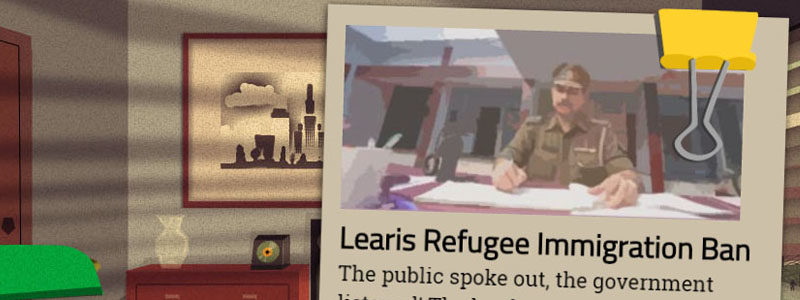
I just released HEADLINER, a short adventure game where YOU control national news and its impact on your career, society and family. It tackles numerous social issues important today, from immigration to healthcare and education. But it was more than just lucky timing - it was based on calculated research that led to some surprising findings.
HEADLINER is a multiple-ending adventure game about approving newspaper articles in a fictional western-ish society where majority of the population is genetically modified. It's basically Papers, Please meets GATTACA with a bigger focus on life outside the office.
The inception was a bit different however - you would go through the articles as quickly as possible, race home before the curfew started, and avoid guards on the way. Time management and gameplay were the primary goal, with story being secondary.
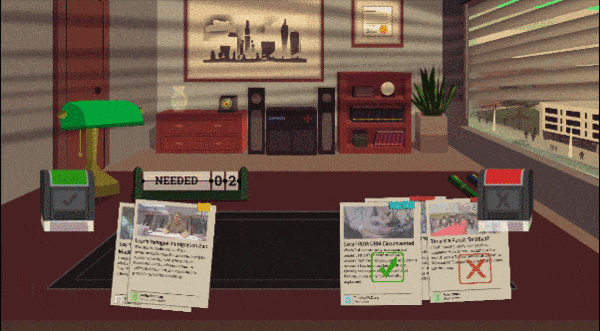
However, as I paid attention to what was happening around the world, my testers' feedback, and my own recently-discovered love for storytelling, the design shifted towards narrative and #FakeNews.
The original script was actually a modernized version of Kristallnacht, a night of anti-Jewish rioting in Nazi Germany predating the start of the second World War. I had a diplomat (who would, spoiler spoiler, get assassinated) and a long trial for the culprit, complete with scandalous "gay romance" allegations.
Problem was - the players didn't care.
The need to read and contemplate articles was at odds with the time mechanic, and the story failed to reverberate with the players. Halfway through the project, I decided to scrap all the time-management mechanics and completely re-write the script. I wanted it to hit the players personally. I wanted them to care. I needed to do some digging.
First, you need to set your research goals right and really think what will increase the game's appeal. This may go deeper than you think,. In HEADLINER, the obvious answer is creating a relatable world and characters to your target audience. While that's the first step, it's really the secondary information.
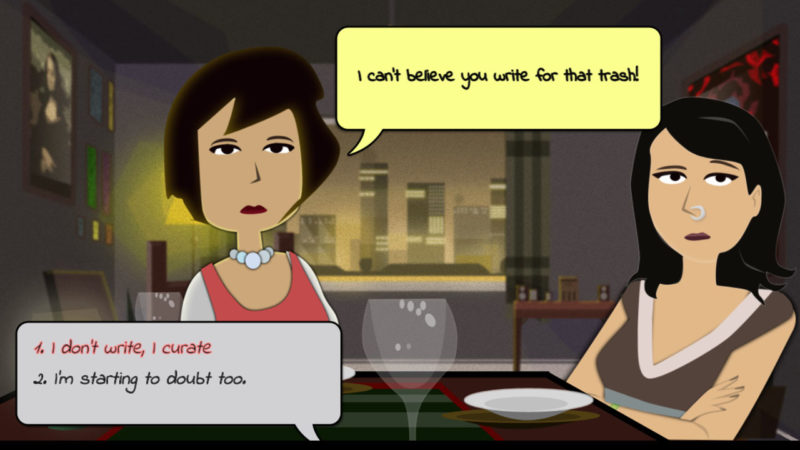
The core "mechanic" of the game is making difficult choices over which articles to approve. Thus, it is those choices we need to make relevant. Given the game already mirrors a contemporary social and media structure, it meant looking at "hot topics" that circulate in the news. No, not what gets broadcasted a lot - what the viewers actually respond to.
So the goal of the research would be to find the social or political issues the player would care about. Which brings us to...
Your game is ALL about the player, so you better figure out who that is. Here, I performed the "Lookalike Target Audience Research," as first described in the excellent article from Launch Your Indie Game. In a nutshell, it uses the Facebook and Google Ad Planner to look at the audience interested in your competitor games (in my case - Papers, Please, Orwell, Gattaca, etc.) and pulling out the data.
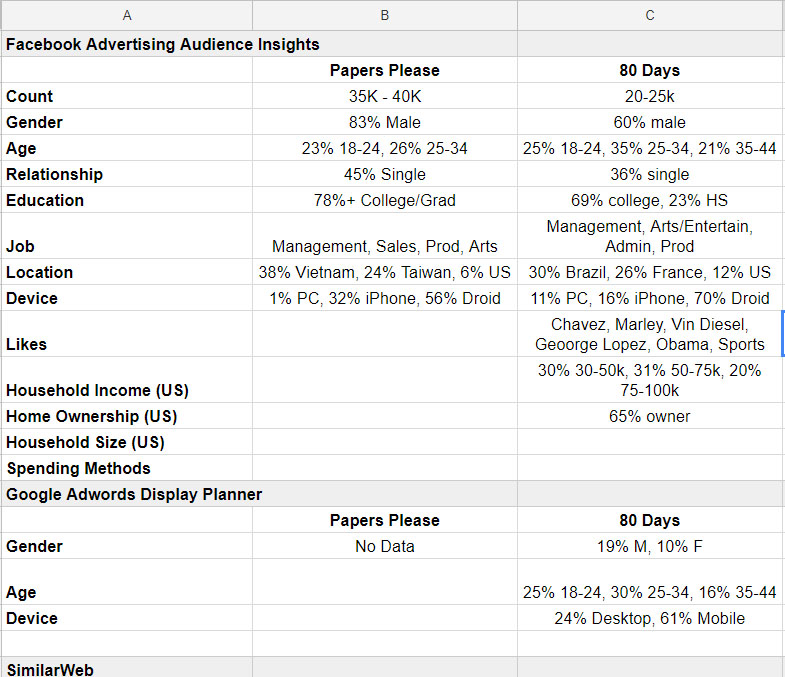
In addition to FB, Google and SimilarWeb, I also looked at stats from SteamSpy, Google Play Store, and Apple Store. Number of downloads and review rates gives you a good idea about potential future sales of your game.
I combined all of this with my the demographics from my last two titles, general observations following the game industry, and a hefty amount of hunch. Thus, I settled on:
20-35 year old male/females, PC gamers, living in North America and Western Europe with a higher level of education and interested in activism
The more specific your audience, the easier it will be to research and, ultimately, appeal to. While I may have discredited some big demographics, I knew I had limited resources and had to keep my scope in check. But if the original idea pans out and good money starts coming in, there's nothing stopping you or me from expanding the scope with new DLC or games.
Now that you know the what and the who, you can finally start mining some data! On your Facebook page, click on the drop-down triangle in the top right of the screen and click "Manage ADs." You may need to set up an ad account so go ahead and do that. From the menu on top, make sure you are on the Ads Manager page. Select the green Campaign, keep it set to Traffic as your goal, and continue to the next screen.
Scroll down and fill in your demographic info such as age, gender, location and language. Now, the Detailed Targetting is where the magic happens! Start off with "video games" as the first interest. Instead of adding the next interest here, click on "Narrow Further" to create a new interest box. If you typed all interests in the same area, it would match any of them, whereas we want to match all of them.

In my case, I added "activism" to be a bit more specific. Now that I had my baseline, I could start mining.
I created a big list of social issues (environmentalism, homelessness, immigration, Syrian refugee crisis, LGBTQ etc.) and would simply add each one as a third required interest. On the right you see the "estimated reach" - this is the number of folks interested in all 3 topics. Bingo!
Rinse and repeat for all of your topics, and you'll acquire a hefty amount of data! You can be even more specific, with more direct locations (maybe you want to do a local promotional event in your city/state?)
Caveat: There are often many groups and pages for any topic or issue your research, so make sure you look at the synonyms (which Facebook will suggest for you, thankfully). For example, I didn't only research environmentalism, but also climate change, global warming, environmental protection, environmentally friendly, and other similar topics. I did not particularly care what someone's stance was, just that they were interested.
Next, let's look at google, which is a bit more general and easier. Aside from the Ad Planner described in the Lookalike Analysis article linked before, I also used Google Trends. Just type in the relevant issue or topic and look at the latest numbers and trends over time. 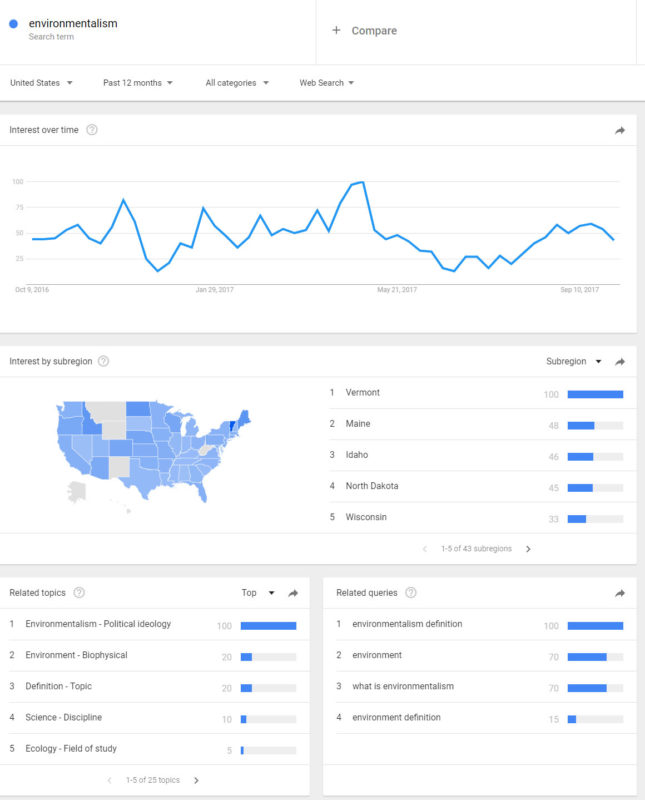
The controls here are rather limited and you can't really focus on a demographic, aside from the country. So take these results with a pinch of salt. And as with FB, look at synonyms as well.
Aside from web research, I've done some local research as well. Since I already work from coffee shops half my day, I would just get up and approach other connoisseurs:
"Hi, I am doing a bit of research, would you mind if I asked you a few questions?"
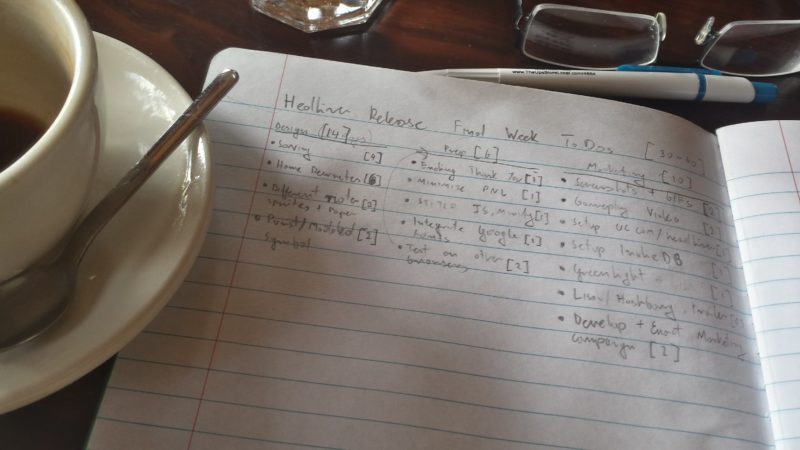
I would ask if they were gamers, and to list the top 3 social issues they were most concerned or involved in. I would usually end up with some follow ups or clarifications as well.
Here, I've faced the reverse of the synonym problem mentioned above. I had to group terms such as "environmental protection" or "global warming" under the same umbrella. They are technically different issues, yes, but for purposes of my research I wanted broader strokes.
Now that you have your data, put it all into a nice spreadsheet! Each row is a different topic (social issue in my case), and each column a different segment (such as FB baseline demographic). I added an extra column to calculate the % (i.e. how many people were interested in an issue, divided by the highest value from all of the topics). Lastly, I applied conditional formatting to color-code it. And behold:
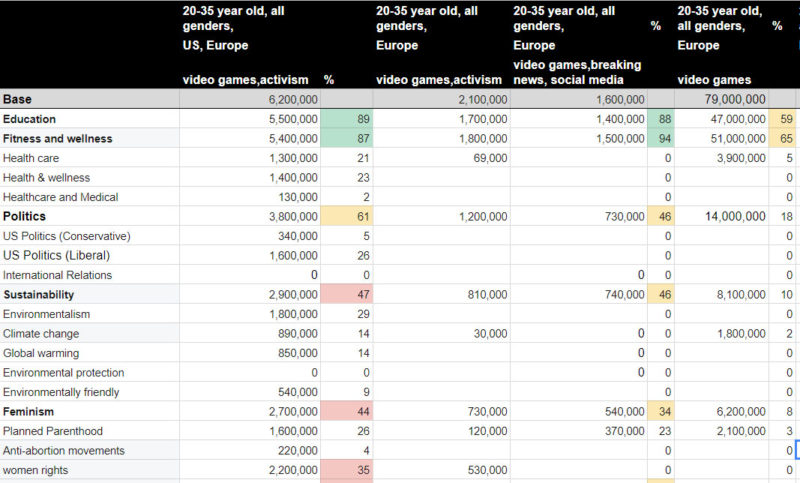
The chart above is from Facebook alone, as it provided most targeted information. I used it for the primary decision making, and the Google and personal interviews as additional data to help make an educated decision.
As soon as you finish, you will likely find some surprising trends and differences. In case of HEADLINER, I was surprised how some of the issues I expected to be high on the list turned out not to be. LGBTQ and marriage equality were far lower compared to the other topics. Likewise, education and health were several times more important than average.
There were also interesting trends when comparing global, national and local levels. The Refugee Crisis was a big deal in Europe, but less so in the US. Likewise, Homelessness was the #1 factor for the Seattleites I interviewed in person, yet didn't even register as a blimp on the other scales.
Overall, these trends can also come in handy in marketing. Perhaps I would have had more success if, at local Seattle events, I really stressed homelessness as one of the topics? Or if I flew for a European expo, I could put screenshots of the refugees first. I do not have a clear answer just yet, as I've only exhibited here a handful of times so far.
Now that you have your data clear, you can make a far more educated decision. And that's a key point I'd like to make - it's still YOUR decision. Sure, your data can completely drive your design if you wish, and that's totally fine (and arguably will make you far more successful than me). But it can also be used as a helping hand to guide and educate your direction.

In case of HEADLINER, I scrapped the entire diplomat and assassin arc, but I kept the motif of rioting and societal unrest. I brought in the issue of immigration and refugees, something I knew would reverbrate in Europe and southern states. I focused the family dilemma on your spous's health issues and the daughter's education.
At the same time, I still kept the topic of LGBTQ-inspired marriage discrimination and unrest over genetic modification of embryos, even tho these did not score as highly in the research. Because it's my game, and I can take creative liberties likes that ;D
I also threw in a celebrity scandal - cause you can't have have a good tabloid without a celebrity scandal.
With the wealth of internet data and countless analytical tools available, anyone can do some basic data mining in a relatively short amount of time. Naturally, each game or idea will require different type of research. If I was developing Limbo-style platformer, I might have looked at whole different topics in a different way. Maybe consider different cartoons to get an idea of what visual style might be most appealing? Maybe look at phobias to see what monsters would most evocative the sense of dread and fear?
Keep in mind that all this data is always fluid, especially when it comes to hot topics such as media and social issues. I've performed this research a few months ago, and already feel it's outdated. Today, hurricane relief or gun rights would probably be the most important topics in the US. It's too late to update the game with those, but I can use that in future episodes or expansions.
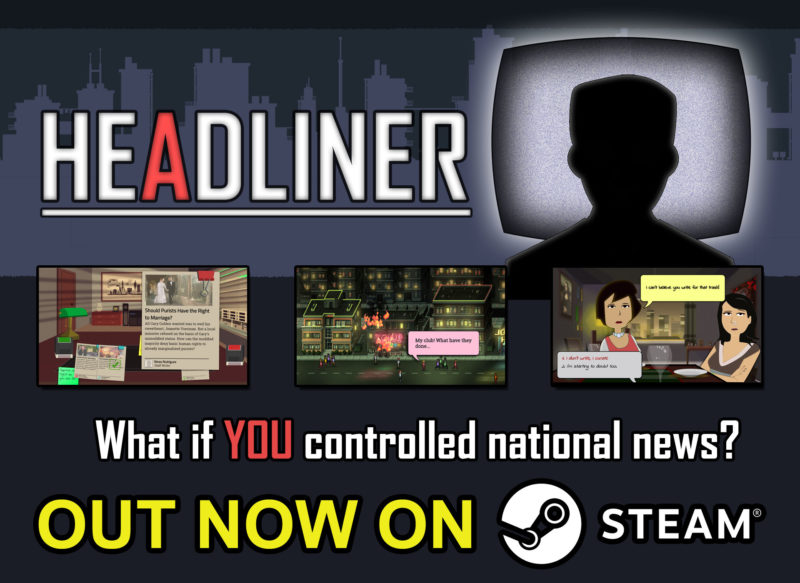
I hope the process outlined above gives a bit of a glimpse into how I made my game feel more relevant to the players today, and all the interesting trends that emerged. Keep in mind there's a lot more you can do, even before you get into the full stage of development. For example, I also researched my inspirations/competitors such as Papers, Please or Westport Independent, reading through almost all the Steam user and critical reviews. I didn't want to merely copy - I wanted to see what worked, what didn't, and really advance the genre.
If you are intrigued, HEADLINER is available on Steam for less than your daily Starbuckscinno! Why not support me, and see how my research worked out in practice?
Thanks for reading and sharing! Happy Mining :)
 Hi! I am a Polish-American, Game Dev and web consultant. I founded Unbound Creations, focusing on story-rich and introspective games. I published two commercial games before (“Postmortem: one must die” and “Karaski”), with HEADLNER being my third. My works have been a finalist at the Pixel Heaven Fest 2015 in Warsaw Poland, and on display at VALA Art Center in Redmond.
Hi! I am a Polish-American, Game Dev and web consultant. I founded Unbound Creations, focusing on story-rich and introspective games. I published two commercial games before (“Postmortem: one must die” and “Karaski”), with HEADLNER being my third. My works have been a finalist at the Pixel Heaven Fest 2015 in Warsaw Poland, and on display at VALA Art Center in Redmond.
Check out my Blog for more nuggets of ill-advised wisdom!
You May Also Like